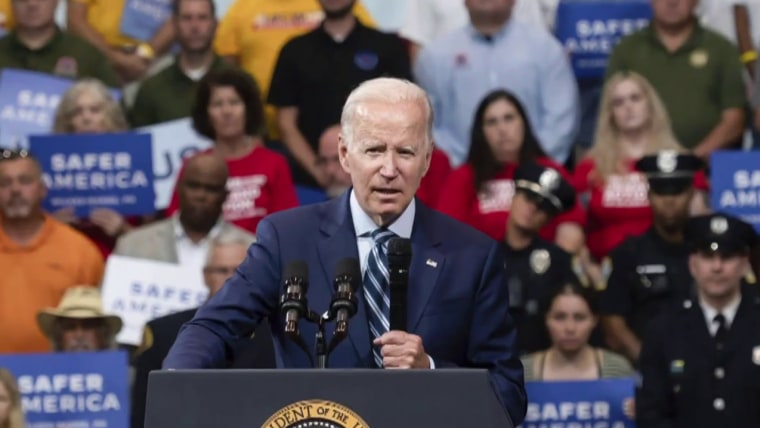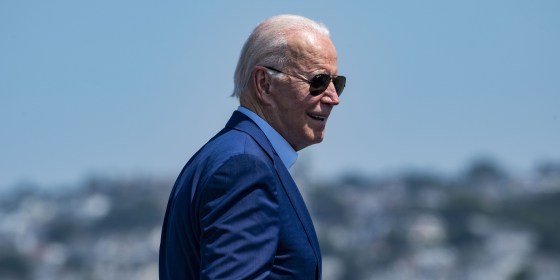A new AP-NORC poll gives President Joe Biden a remarkable 9 point bump in his approval ratings since his low point this summer. That’s great news for Democrats, who are less than two months out from the midterm elections, which increasingly look as if they could be more of a toss-up than was predicted earlier this year. If Biden’s upswing continues, it could help Democrats fend off a Republican takeover of Congress.
While the survey shows Biden is still underwater, it finds him climbing from 36% approval among U.S. adults in mid-July to 45% this past week – in line with a broader uptick in Biden’s job approval over the second half of the summer. What accounts for this revival after inflation fears led many to assume a midterm bloodbath for Democrats? Call it the Dark Brandon effect.
Dark Brandon pierced through the trope of Washington as a place where useful policies suffer slow, painful deaths.
For those unfamiliar, Dark Brandon is a Democratic meme that inverts the anti-Biden “Let’s Go Brandon” meme; if you don’t feel like reading an explainer, all you need to know is that Biden’s surprising string of legislative victories this summer has turned the right-wing narrative of Biden as frail and ineffectual on its head. Last month, Biden and the Democrats shocked the political universe after striking a deal with West Virginia Sen. Joe Manchin to pass some of Biden’s most ambitious climate and health policies through the Inflation Reduction Act. Biden also signed two bipartisan bills – one to enhance economic competitiveness against China, while the other was the first gun safety bill to pass Congress in 30 years. On top of that, he canceled thousands of dollars in student loan debt for millions of Americans.
Keep in mind these victories — which generated a steady stream of favorable coverage — all came after Biden was widely assumed to have hit a wall and exhausted his ability to pass any more substantive bills. Instead Biden as Dark Brandon pierced through the trope of Washington as a place where useful policies suffer slow, painful deaths — and at a time when political polarization is as high as it’s been in recent memory.
Beyond these policies, there's been a consistent rhythm of positive news that helped revive Biden’s ratings, primarily among disillusioned Democrats. Gas prices have declined 26% since June, easing a highly visible source of financial stress for consumers. And while the public’s concern about inflation remains, Americans are trending optimistic about the economy. Perception of the economy as a tough place for consumers is still Biden’s greatest vulnerability, but the fact that some of the anxiety — and news cycles — about rising prices are improving bodes well for him.
There are also some other parts of the summer’s political climate that don’t reflect directly on Biden but might be making the public more receptive to him. The overturning of Roe v. Wade has dramatically shifted Democrats’ perspective on what’s at stake in the midterms. And continued coverage of Trump’s lawlessness, such as his illicit handling of classified government documents — which he seems intent on using to turbocharge his fourth presidential bid — may be reminding voters why they chose Biden two years ago. In other words, Biden could be a beneficiary of heightened contrast with the alternative.

And no matter how much better the rest of the political environment might be shifting, Democrats need Biden’s ratings trending positively as they prepare for Election Day. The party of the president has almost always lost midterm elections since the end of World War II. Political scientists have long debated what explains this — some theories emphasize fired up opposition party turnout; others emphasize voters who flip parties to act as a moderating check on the ruling agenda of the White House.
Regardless of the mechanism, popularity of the president seems to be a valuable proxy for the way the midterm winds are blowing. As Vox’s Andrew Prokop has pointed out, presidential approval ratings are “the clearest predictor of midterm fate.”
“Over the past seven midterms, we’ve had two presidents with over 60 percent approval by midterm time, and they were the two who defied the trend of midterm defeat: Bill Clinton in 1998 and George W. Bush in 2002. (In 1998, Democrats lost the national House vote, but they did pick up seats),” Prokop wrote in an explainer in March.
Biden is far, far away from that. Democrats still have their work cut out for them. But things are looking sunnier than before, and if the economic picture improves the midterm elections could be better — or at least less painful — than seemed certain a few months ago.

